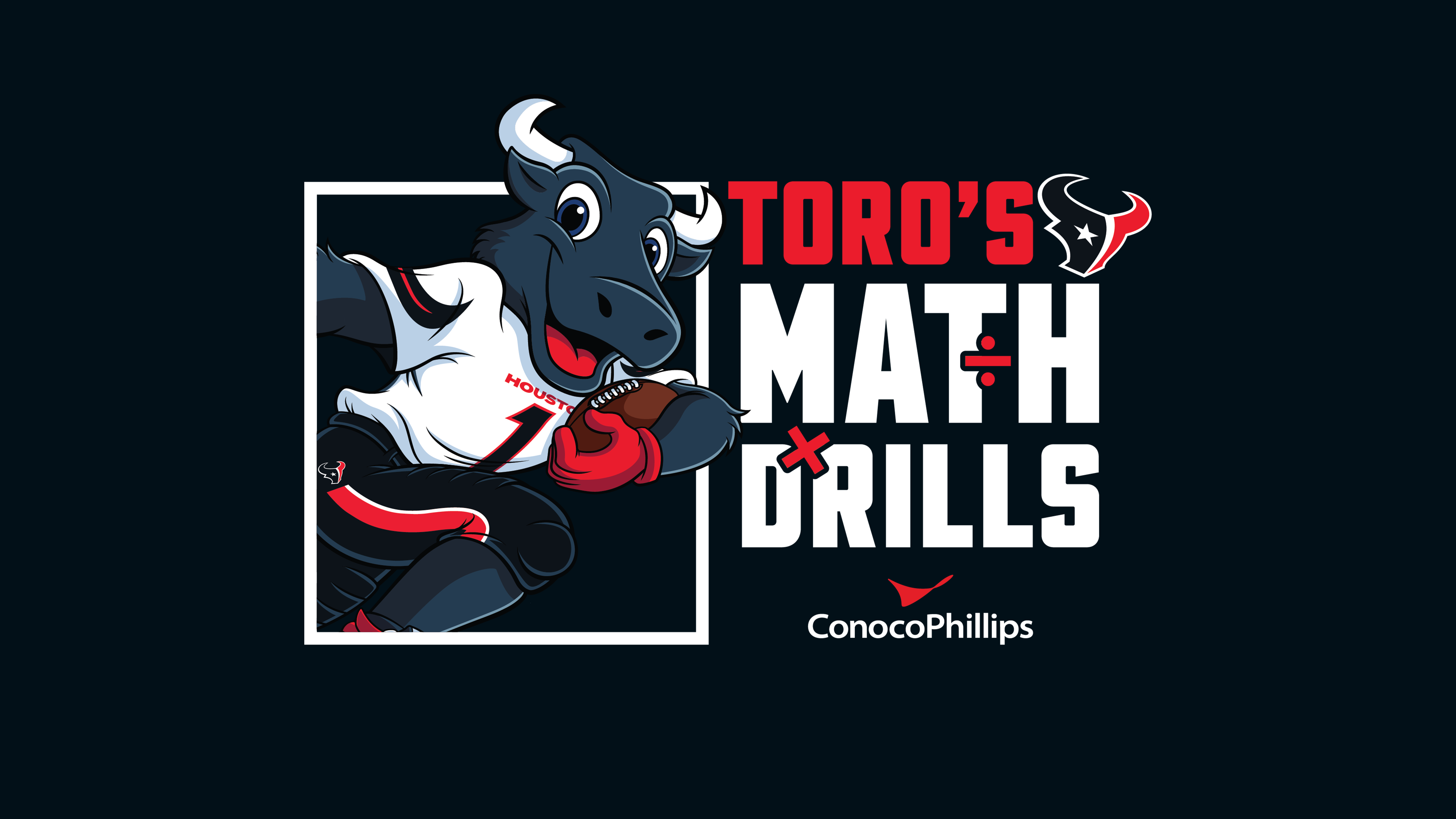TORO's Math Drills | Houston Texans - HoustonTexans.com

The Houston Texans and ConocoPhillips have teamed up to create TORO's Math Drills, an educational video series designed to challenge 3rd and 4th graders. Covering subjects like fractions, multiplication, division, place value, and money, TORO's Math Drills will help your students tackle math through fun and exciting football examples. Teachers, sign up to put your students through TORO's Math Drills!
Questions? Please email TOROsMathDrills@houstontexans.com
TORO's Math Drills presented by ConocoPhillips was developed in collaboration with our education partner, United Way of Greater Houston.
Instant Replay: The worksheets below are for your students to complete along with or after watching the videos.

Angles
TEKS Referenced:
4.7 (C) - Determine the approximate measures of angles in degrees to the nearest whole number using a protractor

Data Analysis
TEKS Referenced:
3.8 (A) - Summarize a data set with multiple categories using a frequency table, dot plot, pictograph, or bar graph with scaled intervals;
4.9 (A) - Represent data on a frequency table, dot plot, or stem-and-leaf plot marked with whole numbers and fractions
4.9 (B) - Solve one- and two-step problems using data in whole number, decimal, and fraction form in a frequency table, dot plot, or stem-and-leaf plot

Algebraic Reasoning
TEKS Referenced:
3.5 (E) - Represent real-world relationships using number pairs in a table and verbal descriptions.
4.5 (B) - Represent problems using an input-output table and numerical expressions to generate a number pattern that follows a given rule representing the relationship of the values in the resulting sequence and their position in the sequence;

Volume
TEKS Referenced:
- 3.7 (D) - Determine when it is appropriate to use measurements of liquid volume (capacity) or weight.
- 3.7 (E) - determine liquid volume (capacity) or weight using appropriate units and tools.
- 4.8 (C) - Solve problems that deal with measurements of length, intervals of time, liquid volumes, mass, and money using addition, subtraction, multiplication, or division as appropriate.

Multi-Step Operations
TEKS Referenced:
•3.4 (K) – Solve one and two-step problems involving multiplication and division
•4.4 (H) - Solve with fluency one- and two-step problems involving multiplication and division, including interpreting remainders.

Financial Literacy
TEKS Referenced:
•3.9 (F) - Identify decisions involving income, spending, saving, credit, and charitable giving
•4.10 (A) - Distinguish between fixed and variable expenses

Place Values
TEKS Referenced:
•3.1(A) - apply mathematics to problems arising in everyday life, society, and the workplace.
•3.2(A) - compose and decompose numbers up to 100,000 as a sum of so many ten thousands, so many thousands, so many hundreds, so many tens, and so many ones using objects, pictorial models, and numbers, including expanded notation as appropriate.
•4.1(A) - apply mathematics to problems arising in everyday life, society, and the workplace.
•4.2(A) - interpret the value of each place-value position as 10 times the position to the right and as one-tenth of the value of the place to its left.
•4.2(B) - represent the value of the digit in whole numbers through 1,000,000,000 and decimals to the hundredths using expanded notation and numerals.

Fractions
TEKS Referenced:
•3.1(a) - apply mathematics to problems arising in everyday life, society, and the workplace.
•3.3(A) - represent fractions greater than zero and less than or equal to one with denominators of 2, 3, 4, 6, and 8 using concrete objects and pictorial models, including strip diagrams and number lines.
•4.1(A) - apply mathematics to problems arising in everyday life, society, and the workplace
•4.1(C) - select tools, including real objects, manipulatives, paper and pencil, and technology as appropriate, and techniques, including mental math, estimation, and number sense as appropriate, to solve problems

Money
TEKS Referenced:
•3.1(A) - apply mathematics to problems arising in everyday life, society, and the workplace;
•3.4(C) - determine the value of a collection of coins and bills;
•3.9(C) - identify the costs and benefits of planned and unplanned spending decisions;
•3.9(F) - identify decisions involving income, spending, saving, credit, and charitable giving.
•4.1(A) - apply mathematics to problems arising in everyday life, society, and the workplace;
•4.2(E) - represent decimals, including tenths and hundredths, using concrete and visual models and money;
•4.4(A) - add and subtract whole numbers and decimals to the hundredths place using the standard algorithm;
•4.10(B) - calculate profit in a given situation

Multiplication and Division
TEKS Referenced:
•3.1(A) - apply mathematics to problems arising in everyday life, society, and the workplace;
•3.4(E) - represent multiplication facts by using a variety of approaches such as repeated addition, equal-sized groups, arrays, area models, equal jumps on a number line, and skip counting.
•3.4(K) - solve one-step and two-step problems involving multiplication and division within 100 using strategies based on objects; pictorial models, including arrays, area models, and equal groups; properties of operations; or recall of facts.
•4.1(A) - apply mathematics to problems arising in everyday life, society, and the workplace.
•4.4(B) - determine products of a number and 10 or 100 using properties of operations and place value understandings.
•4.4(C) - represent the product of 2 two-digit numbers using arrays, area models, or equations, including perfect squares through 15 by 15.
•4.4(E) - represent the quotient of up to a four-digit whole number divided by a one-digit whole number using arrays, area models, or equations.
•4.4(F) - use strategies and algorithms, including the standard algorithm, to divide up to a four-digit dividend by a one-digit divisor.

Shapes
TEKS Referenced:
•3.1(A) - apply mathematics to problems arising in everyday life, society, and the workplace.
•3.6(A) - classify and sort two- and three-dimensional figures, including cones, cylinders, spheres, triangular and rectangular prisms, and cubes, based on attributes using formal geometric language.
•4.1(A) - apply mathematics to problems arising in everyday life, society, and the workplace.
•4.6(D) - classify two-dimensional figures based on the presence or absence of parallel or perpendicular lines or the presence or absence of angles of a specified size.

Perimeter and Area
TEKS Referenced:
•3.1(A) - apply mathematics to problems arising in everyday life, society, and the workplace;
•3.6(C) - determine the area of rectangles with whole number side lengths in problems using multiplication related to the number of rows times the number of unit squares in each row;
•3.7(B) - determine the perimeter of a polygon or a missing length when given perimeter and remaining side lengths in problems
•4.1(A) - apply mathematics to problems arising in everyday life, society, and the workplace;
•4.5(C)(D) - use models to determine the formulas for the perimeter of a rectangle (l + w + l + w or 2l + 2w), including the special form for perimeter of a square (4s) and the area of a rectangle (l x w); and solve problems related to perimeter and area of rectangles where dimensions are whole numbers.

